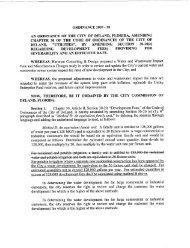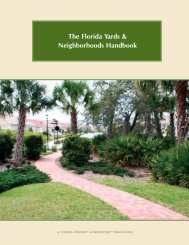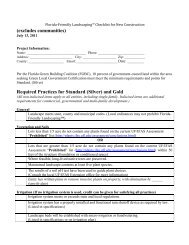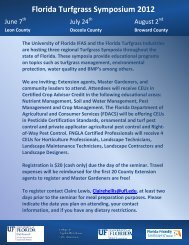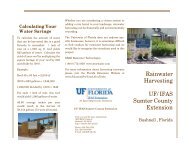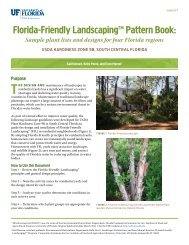A Guide to Florida-Friendly Landscaping A Guide to Florida-Fr ...
A Guide to Florida-Friendly Landscaping A Guide to Florida-Fr ...
A Guide to Florida-Friendly Landscaping A Guide to Florida-Fr ...
You also want an ePaper? Increase the reach of your titles
YUMPU automatically turns print PDFs into web optimized ePapers that Google loves.
■<br />
■<br />
■<br />
■<br />
■<br />
also create habitats for rodents that<br />
chew the bark and can girdle the trees.<br />
Mulch out <strong>to</strong> a tree’s drip line or beyond,<br />
at least an 8-foot diameter around the<br />
tree. Remember that in a forest<br />
environment, a tree’s entire root system<br />
(which usually extends well beyond the<br />
drip line) would be mulched.<br />
Thick blankets of fine mulch can become<br />
matted and may prevent water and air<br />
from seeping through, or become like<br />
potting soil and may support weed<br />
growth. Rake old mulch <strong>to</strong> break up any<br />
matted layers and <strong>to</strong> refresh the<br />
appearance.<br />
Organic mulches may require weeding<br />
and replenishment once or twice a year<br />
<strong>to</strong> maintain a <strong>to</strong>tal depth of 2"–3".<br />
Do not use cypress mulch because<br />
harvesting from the wild depletes wetlands.<br />
Shell, crushed s<strong>to</strong>ne or pebbles can be used as mulch but they won’t<br />
contribute <strong>to</strong> the soil’s nutrient and organic content or water-holding<br />
capacity. Limes<strong>to</strong>ne and shell both raise soil pH. They also reflect heat,<br />
increasing the water needs of plants.<br />
Pho<strong>to</strong> by: Ed Gilman, University of <strong>Florida</strong>.<br />
Mulch that is <strong>to</strong>o deep or <strong>to</strong>uching the trunk<br />
is applied improperly. This is commonly referred<br />
<strong>to</strong> as “volcano mulching."<br />
<strong>Florida</strong> Yard Tip:<br />
How Much Mulch?<br />
Bulk quantities of mulch are sold in cubic yard volumes. To calculate the<br />
amount of mulch you need, first measure the area <strong>to</strong> be mulched, in<br />
square feet. Next convert the desired depth <strong>to</strong> a fraction of a foot. For<br />
example, 3" divided by 12" equals ¼ ft. or 0.25 ft. Multiply this fraction by<br />
the square foot measurement of the area <strong>to</strong> be covered (.25 feet x 100<br />
square feet = 25 cubic feet). Convert cubic feet <strong>to</strong> cubic yards by dividing<br />
cubic feet by 27 (25/27 = .926). To cover a 100-square-foot area <strong>to</strong> a depth<br />
of 3”, you will need .926 cubic yards of mulch.<br />
http://edis.ifas.ufl.edu/MG251<br />
61



